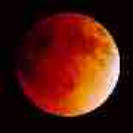
Although lunar eclipses are less dramatic than solar eclipse, they can potentially be seen by many more people.
A lunar eclipse occurs when the Moon passes through Earth’s central shadow, or umbra. Lunar eclipses
typically last for no more than two hours and can be seen by virtually everyone on the night side of Earth. Just
as with solar eclipses, there will be a lunar eclipse somewhere every six months or so.
Lunar eclipses occur rather often and your chances of being able to see them are actually quite high. It is true they are not
quite as dramatic as a solar eclipse. There are no atmospheric effects, no change in temperature. One could be outside, looking
in the wrong direction, and not even realize that a lunar eclipse was occuring. But they do have their own special beauty.
Depending on the condition of Earth's atmosphere at the moment, the Moon can be a subtle salmon color or blood red at
the time of totality. If you did not know what to expect, such an event in the sky could be quite frightening. Christopher Columbus
used this to good effect on his fourth voyage to the Americas. But as you will note on the linked page, Columbus still did not
know where he actually was on the globe.
To give you an idea of the look of a lunar eclipse, here is a picture of a lunar eclipse and a gallery of many more.
Here is a list of the eclipses we can expect to see for the next few years, from a leading expert in eclipse prediction, Fred
Espenak.
Lunar Eclipses: the next twenty years or so.





















